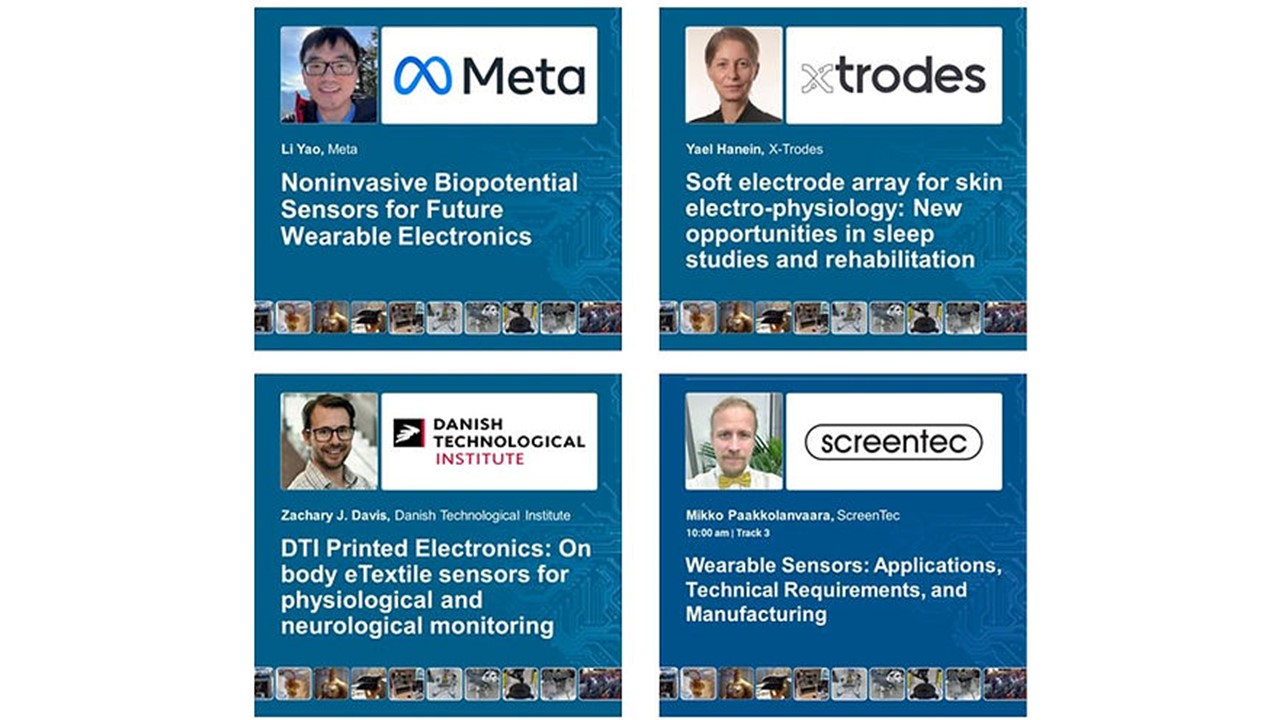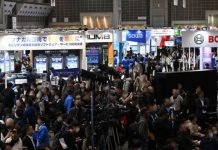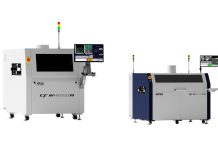We have prepared a world-class agenda for you, featuring over 70 superb invited talks from around the world, 12 industry- or expert-led masterclasses, 4 tours, and over 80 onsite exhibitors.
In this article series, we highlight various talks in the program, outlining the technologies and applications that will be showcased in the program.
In this article, we discuss the theme of wearables, e-textiles, and printed medical sensors, highlighting contributions from the likes of Meta, Air Force Research Laboratory, X-Trodes, Creative Materials, PolyPhotonix, Light Tree Venture Group, Nagase ChemteX, Texavie, Danish Technological Institute, Sun Chemical, Nanoleq, Profactor, ScreenTec, and Elitac Wearables.
In follow-up articles, we highlight many more contributions on this theme as well as other key themes such as sustainable electronics, materials innovations, smart surfaces, additive and 3D electronics, medical electronics, photovoltaics, packaging, novel materials, lighting applications, etc. Stay tuned!
Wearable Sensors
-
Meta wil join us from the US to present, offering an overview of the current state of non-invasive biopotential sensors for future wearable electronics including EEG, ECG, and EMG. Non-invasive biopotential wearable sensors offer many clear benefits over conventional approaches, hence the growing market interest. Furthermore, Meta will highlight the challenges as well as promising future prospects for these sensors, including their integration into wearables devices and potential influence on human-computer interactions.
-
X-Trodes will join us to discuss their soft electrode array technology for wearable skin electro-physiology. This is a technology that enables electrophysiology to be applied outside labs into freely behaving humans in their normal daily activities. This is an impressive solution, combining printed dry electrodes with wireless sensors, data storage, and automated data analysis. Here you can learn about the underlying technology, benchmarking data vs clinic-based conventional solutions, and the future roadmap.
-
ScreenTec will join us as a masterclass instructor, offering a real manufacturer’s perspective on commercial development and mass production of printed wearable sensors. This is a must-attend class for anyone interested in the field as it offers unique insights, helping understand real technical and cost requirements for printed wearable sensors.
-
Danish Technological Institute(DTI) will also present on its one-stop-shop approach. This is an important ecosystem development which will help accelerate idea-to-product especially in the European ecosystem. You can learn how this one-stop-shop can guide you in the development of wearable sensors and e-textiles from feasibility studies to design to prototyping and even small scale manufacturing.
Electronic Textiles
-
Texavie will join us from Canada to present on their novel smart apparel technology aimed at personalized therapy and wellness solutions. This innovative approach combines advanced yarn sensor technology and flexible smart textiles with machine learning, AI and data analytics to provide real-time monitoring and personalized feedback with high accuracy and fidelity. This is a unique approach both at the hardware level but also at the level of creating a full solution encompassing all steps from wearable sensors, hardware, and data analysis.
-
Nanoleq will join us to present its novel silicone-based non-invasive dry electrode technology, which enables capturing ECG with HR and HRV, EMG or EEG in high quality, or to even stimulate muscles and nerves. This novel mass production-ready technology is based on silicone dry and washable adhesive electrodes, designed to be integrated into intelligent textile garments using thermo adhesive systems common in standard textile bonding.
-
PROFACTOR will present a digital inkjet-based method of integrating electronic circuits and sensors onto textiles. Most alternative approaches use screen printing or some type of conductive fibers or yarns. The digital printing offers unique customization advantages inaccessible to alternative methods. In this talk, an inkjet-printed breath rate sensor, accelerometer and pulse sensor were integrated on a stretchable fabric and evaluated under conditions akin to human respiration.
-
Elitac Wearables will join us as a masterclass instructor, offering a class on integration methods of electronics including sensors, actuators, interconnects, power, etc into textiles. The interaction method is a complex yet crucial theme in e-textiles influencing design, manufacturing, and functionality. This class draws upon years of experience, helping the participant navigate the design process and select the right solutions to create smart wearables and electronic textiles. This is a must-attend class.
Materials
-
Air Force Research Laboratory will join the conference from the US to discuss liquid metals as printable materials. Liquid metals are a unique and emerging class of conductive materials that offer truly unmatched stretchability, meaning that they could be integrated into or onto textiles, fibers, etc to enable various sensors and circuits. This is an important development since the advancement of wearables and e-textiles – and generally soft and stretchable electronics – is not possible without further material advancements.
-
Sun Chemical will present the latest insights on biosensor ink technology. This is crucial since inks play a foundational role in any printed biosensors. As the application space evolves including the rise of continuous monitoring and applications with prolinted skin or analyte solution contacts, the material requirements for ink systems change. Here, you will learn the latest trends and technical developments.
-
Nagase ChemteX will also present the latest results on their washable and stretchable ink systems. This is an important contribution as the focus is on the latest developments in the washability of conductive inks in conjunction with various substrate and material systems, a vital feature and figure-of-merit for any wearable or e-textile system based on printed electronics.
-
Creative Materials will also offer critical insights into ink and material selection for skin patch printing and manufacturing. This is important because careful selection of materials and patch geometry ensure maximum durability and user comfort. There are many considerations including thickness, moduli for mechanical matching of ink and substrate systems, chemical compatibility, interfacing joints, etc. Here you can learn how to design multivariable experiments to optimize the final device bill of materials
Light Therapy
Light therapy is growing in importance. Flexible electronics inevitably play an important role in this area. To this end, we have organized several interesting talks and visits.
-
Light Tree Venture Group will present its large-area flexible LED foil system that can be integrated into various products for wearable therapy devices. This is a mass-produced product with unique features and unique manufacturing methods.
-
PolyPhotonix will also present its novel wearable OLED-based sleep mask that enables the treatment of diabetic eye diseases using light from thin OLEDs integrated into the sleep mask. This is an innovative product backed with strong data and is also in use.
-
Finally – when it comes to flexible lighting – you will have a unique opportunity to visit the Inuru factory in Berlin– the first company in the world that will mass-produce flexible OLED lighting with inkjet printing. This -to our minds – is one of the most exciting projects in printed electronics and is a tour that should not be missed!
To learn more and register, visit www.techblick.com/agenda-2024-berlin.










